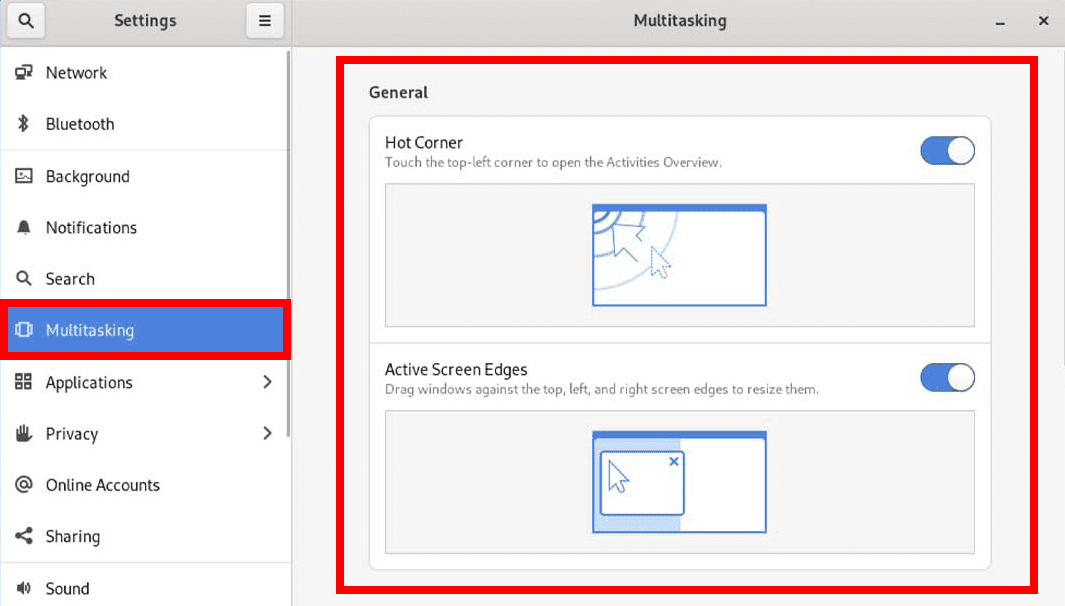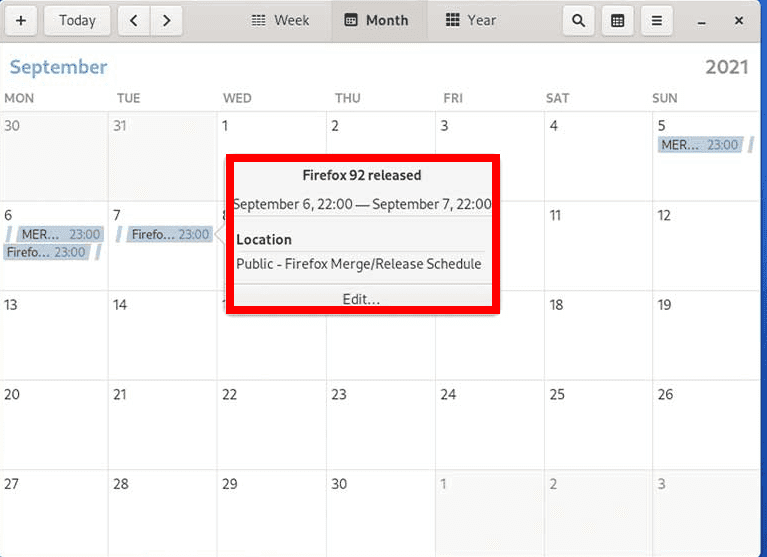The long-awaited GNOME 41 is out! It contains many new exciting features compared to the previous GNOME 40. We have seen GNOME’s improvements since the first article covered GNOME 3.38 to the latest release, GNOME 41. The rapid technological improvements and advancements are critical articulations to the newer releases that we shall expect in the future.
GNOME 41 beta, which showcases the new numbering system, is already out awaiting the stable release in September. This beta release will give you a taste of what you will expect when the official version is released.
Like the GNOME 40 release, the GNOME 41 already out does not contain many desktop layouts rejigs. However, many other improvements have been made, and we shall cover them in this article.
Top new features of GNOME 41
1. Performance boost
The GNOME 41 seems interesting with a lot of new fresh performance boosts. The low refresh rates benefit the display from reduced input latency, a multitouch gesture that is consistently in use. In addition, the transition workspace is defined as being more seamless here than the previous GNOME release.
Mutter, the known GNOME’s Display manager, has been subjected to a significant code clean up boosting its performance.

gnome 41 performance boost
2. Nautilus Tweaks
The nautilus tweaks bring about a different look and feel on GNOME 41. It includes an additional bar when viewing the Trash/Bin folder. The bar is effective and vital in letting you know when the auto trash emptying service is active. It also contains quick privacy settings links that enable the users to perform other tasks, such as facilitate auto emptying of the trash/bin.
Are you keen on file compression, then you should be pleased with the Nautilus since it features a redesigned “compress” dialog that supports the creation of encrypted.zip archives? The exciting part about the dialog is that it is task-focused and edges other dedicated archives and compression applications.

gnome 41 create encrypted archives
3. Connections
This is a new application provided by GNOME 41. If you are a GNOME fan, then this new feature should excite you. The new connections app provides perfectly tiled connections hence being a charm to many.
With these new connections features, it is possible to connect and switch between different remote sessions simultaneously. This prevents users from juggling between several operating systems, which might slow down the operating speed of your PC in the long run.
The connections app is superb at handling errors and providing possible solutions to the found errors whenever things go astray.
The most eye-catching improvements came from the “onboarding” screens that used terrific artwork, including GNOME-style icons, Windows, macOS, and other fabulous icons.
The graphical interface of the “New connection” app simplified the creation of new connections. This is a feature that many users love.

gnome 41 connections
4. Power Option provided in the status menu
Who wouldn’t love to access the power options on the status menu? The Gnome 40 introduced the power profiles to the settings application. The GNOME 41 dev-ops have significantly improved as they have incorporated the power profiles and options into the status menu. This feature enables users to evade the stress of opening the settings application to alter power options.
Additional and exciting improvements made on GNOME 41 is the automatic integration of power profiles to suit the selected power mode. For instance, when you opt for the battery power mode from the power profiles, the low power mode is automatically activated. This feature is vital and is loved by many. However, if you find it boring, you have the option to disable it and select the power mode you want manually.
While using GNOME 41, you will also realize that the screen brightness is deemed aggressively when running in low power mode. This is an auto feature integrated into the power profiles. If you don’t love the feature, you can turn it off.
Note: apps automatically request the power profiles for the duration they run. An example is a game that might request the device to switch to a high-performance profile whenever it is active. Then, when you end the game, the power mode and profile are restored to normal. You should try out this feature since we found it to be fascinating.
The GNOME 41 developers have designed the power settings in a manner it lets the user know whenever an app requests to change a profile since it impacts the overall performance. You can either allow the app to request permission or deny it the privileges to change the profile settings. This solely depends on your preference, thanks to the dev-ops.

gnome power profiles in the status menu
5. The new Multitasking Panel
With the GNOME 41 cycle already out in the beta version, various updates are already made to the GNOME Control Center. However, out of these updates, the most outstanding is the new multitasking panel.
Many configuration options have been configured to this GNOME shell desktop requiring the aid of the GNOME tweak application. Some of the most notable configurations are:
- Active screen edges disable
- Hot corner disable
- App switching preferences
- Multi-monitors workspace behaviors
- Fixed number workspace dynamics
Apart from the multitasking panel, which is seen as the new addition to the GNOME control center, the new cellular panel is another introduction released in GNOME 41. The cellular release is efficient in configuring modems and mobile connections.
Like all other panes in the Control Center, the new cellular section appears only when the compatible hardware is present. Therefore, if you don’t see it, don’t freak out.
Other notable tweaks available on GNOME 41 are the new accessibility setting used in disabling animations in the GNOME shell and new colorful artwork in the Touchpad and Mouse settings.

gnome 41 features a multitasking panel
6. The GNOME Calendar 41
I know most of you haven’t realized that in GNOME 40, you could not make the GNOME calendar the default calendaring application. However, if you still have the GNOME 40, you can try it out. For instance, the default calendaring application in my Ubuntu 21.04 is the Text Editor.
Technically, the GNOME calendar couldn’t be made the default calendaring app because it was not a file handler.
However, this is not the case with the GNOME calendar 41, whereby you can make it the default calendaring app. Thanks to the developers, the .ics files and import events let the users add the calendar to the pre-configured calendars. Besides, the new GNOME 41 calendar contains a new event popover that makes it easier for users to see the event information on hover.

gnome 41 new popover in calendar
7. Assorted App Updates
Several app updates were released in GNOME 41. The updates include:
GNOME maps: The updates provide fixes for many bugs. It iterates the use of icons, displays the takeaway information for food services and restaurants whenever available. Besides the updates, the Facebook check-in has also been integrated into the maps.
GNOME Disk Utility: The new updates on the disk utility enables the users to create new encrypted partitions with the LUKS2. Some of the icons have been improved for better clarity. Filesystem ownership ability has also been integrated.
The calls app: With new elements incorporated in this release, the UI elements are used to manage SIP accounts and make/receive VoIP calls.
Web: The Epiphany browser in this release can retain the pinned tasks between sessions, making it very handy. You can try out this feature now. Besides, the dark mode support has been improved in this release; hence you are certain about continued support.
Music app: the music application has been improved with significant basic capabilities getting various UI tweaks such as the play/pause button in the player control bar.
GNOME Text Editor: in GNOME 41, the text editor gains zooming keyboard shortcuts. Its preference implementation is upgraded with the slick adaptive sidebar. This is something most users will love to see and use.
8. GNOME Software 41
The new GNOME software contains a new icon-based header stip. In addition, the “Explore” homepage features a new bold layout with colorful category tiles, bigger featured app banners, and informative excerpts. These features sum up to a dynamic store whose look and feel are more informative and engaging than the previous versions.
One of the benefits obtained from the newly released GNOME 41 is the app listing pages. Application screenshots have been put to better use while, on the other hand, improving the relay of information regarding the applications via the help of app information tiles.
The general UI improvements made in GNOME41 software are eye-catching, along with the improved display and surfacing application. Software repository dialogs have been redesigned, making it much better compared to GNOME 40.
The GNOME 41 software, in general, integrated belter styling of installed apps, pending updates, plus other new icons that were peppered all through.

gnome-software 41 new look
9. Inclusion of Libadwaita
This is one of the most notable improvements made in GNOME 41. Libadwaita is primarily based on the libhandy UI library while also being a GTK4 port. Libadwaita will provide the user ability to ship the Adwaita stylesheet plus all the other variants. In the coming days, the libhandy will define the GNOME GTK4 applications UI/UX experience.
10. The new GNOME Calculator
The GNOME calculator in GNOME 41 is completely overhauled. With the new releases, the latest version of the GNOME 41 calculator contains bright color buttons used in removing numbers and displaying the equal sign. The developers were able to develop the UI menu from the hamburger menu that shows the calculator modes.

gnome new calculator interface
The features mentioned above are some of the outstanding features you will encounter in GNOME 41. However, we expect more changes shortly since the official release has not been completed. Below is a summary of the GNOME41 release schedule:
- GNOME 41 Alpha – July 10, 2021
- GNOME 41 Beta – August 14, 2021
- GNOME 41 RC – September 4, 2021
- GNOME 41 – September 22, 2021
The GNOME 41 developers are pushing to craft an ideal distraction-free experience for their users hence the numerous changes and features you encounter whenever an update is released.
The GNOME OS 41 Beta is intended for use with the GNOME boxes; therefore, it may fail to boot in VM software.
Note: The GNOME 41 will not ship with Ubuntu 21.10. However, GNOME 41 apps will be allowed. GNOME 41 PPA might be provided, though; there are fears that they won’t be official or supported by Ubuntu.
You can download the GNOME 41 Beta OS ahead of its stable release on September 22, 2021.
Try out GNOME 41 and let us know via the comments section your thoughts about the new features.

